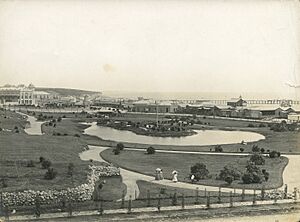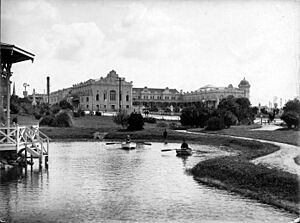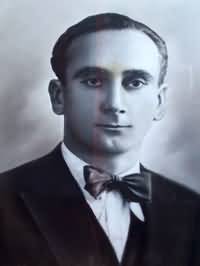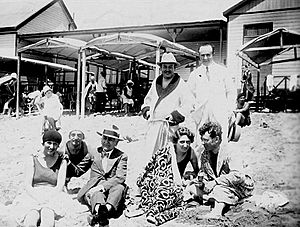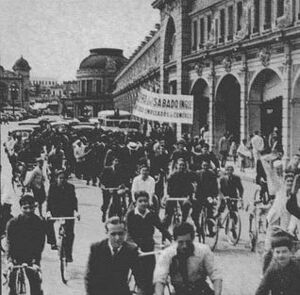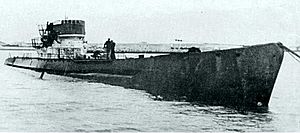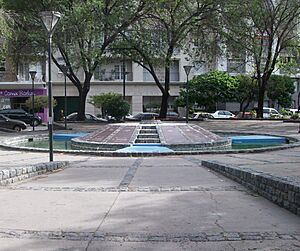History of Mar del Plata facts for kids
The first European explorer to visit the beautiful beaches and cliffs of what is now Mar del Plata was Sir Francis Drake in 1577. He was on a trip around the world. He named the area Cape Lobos because there were so many sea lions there. Lobos de mar means sea wolves in Spanish. Today, this cape is called Cabo Corrientes.
Just four years later, in 1581, Don Juan de Garay, the Spanish Governor of the River Plate, explored the land. He was the second person to found Buenos Aires. He loved the scenery and called it a muy galana costa, which means "a very elegant shore." This phrase is still a favorite saying for the city today.
In 1742, during a war, eight sailors from a British ship survived a shipwreck. They lived through a tough ten-month period before being captured by the Tehuelches, a nomadic tribe. The Tehuelches eventually handed them over to the Spanish.
In 1746, the Spanish Kingdom ordered a Jesuit Order's mission to be built. It was located near what is now Laguna de los Padres, about 8 miles (13 km) west of the modern city. However, the mission was soon abandoned. This happened after several attacks by the northern Tehuelches, led by their chief, Cangapol. The area was not settled by Europeans again until 1856. That year, a facility for salting meat was built by a Portuguese businessman named Coelho de Meirelles. This led to a permanent community settling there.
Contents
How Mar del Plata Began (1874–1930)
The town of Mar del Plata was officially founded on February 10, 1874. This happened because of a government order and the efforts of Patricio Peralta Ramos. Three years later, a Basque merchant named Pedro Luro had an idea. He wanted to turn the growing town into a fancy European-style beach resort.
The railway started to expand into the province. This made it easier for people from the capital city to visit places that were once hard to reach. The very first passenger train arrived in Mar del Plata from Buenos Aires in September 1886. A big event for the wealthy people of Buenos Aires was the opening of the town's first hotel, the fancy Bristol Hotel, in 1888. Many of them traveled by overnight train just for the opening.
The railway also brought many European immigrants, mainly from Italy, Spain, and France. Among the Italians, people from Sicily and Calabria started the first fishing businesses in the 1890s. However, the actual port of Mar del Plata was not built until 1916 by a French company.
At first, the richest people in Argentina still preferred to travel to Europe for their holidays. But when World War I started in Europe, it became harder to travel across the Atlantic. This made Mar del Plata a very popular and exclusive tourist spot. Many new buildings were constructed to meet the needs of this new resort town.
In the late 1920s, wealthy Argentine families started building large houses and mansions near the Bristol Hotel. They would spend their days at the Playa Bristol beach. They often stayed in Mar del Plata from November until Easter.
This difference between the rich visitors and the local people caused some tension. The national government, which was controlled by the Conservative Party, often interfered in the town's local government. In 1911, some residents wrote a public statement asking for less influence from the powerful national elite. These efforts led to the Socialist party winning power in 1919. This was a big change for the "summer home" of Argentina's wealthy families. The national government also changed, with Hipólito Yrigoyen becoming President of the Republic.
Rise of Mass Tourism (1930–1970)
Argentina's first military coup happened on September 6, 1930. This brought back the power of the conservative party at all levels of government, including in Mar del Plata. Even though this new government was not very popular, it did bring some improvements and investments to the country, which was struggling during the Great Depression.
Mass tourism began to grow in the 1930s, helped by better roads. But it really took off in the 1940s and 1950s. During the time of Juan Perón's presidency, many hotels run by unions were developed. This made Mar del Plata affordable for Argentina's middle and working classes. Perón's government, even though it was elected by many people, sometimes used similar methods to the old conservative rulers. In Mar del Plata, this meant that mayors were often appointed by the provincial Governor, instead of being elected. None of the mayors elected during Perón's time finished their full term.
However, the social changes that Perón brought greatly boosted Mar del Plata's economy and its middle class. The city grew like never before.
But there were also accusations of corruption and poor management. This led to a military and civilian uprising called the Revolución Libertadora, which overthrew Perón on September 16, 1955. In Mar del Plata, the Navy supported the rebels, while the Army stayed loyal to the government. The naval base and parts of the city were heavily shelled from the sea before the loyal forces were defeated.
The 1950s were a time of economic growth for Mar del Plata. The 1960s saw a huge boom in the building industry. The amount of construction happening was incredibly high, even more than in big cities like São Paulo, Brazil. This growth happened during a time of political unrest in Argentina. Even though the military banned Perón's party, there were some periods of constitutional government. During these times, the Socialists usually controlled the local government in Mar del Plata. The 1960s were one of the most successful decades in the city's history.
World War II Stories
On July 10, 1945, two months after the end of World War II in Europe, a fishing boat leaving Mar del Plata port found a rusty German submarine. This U-boat, U-530, had left Norway in March with 54 men. After a failed attack near New York City, the submarine received a message to surrender. However, the commander, Otto Vermouth, was confused because he had also heard a secret code that meant all U-boats should be sunk. He decided to sail south instead and reached Argentina in early July. Before entering the port to surrender, Vermouth threw away secret codes, machines, and weapons. The crew was taken by bus to Buenos Aires.
On August 17, another German submarine, U-977, was found near the naval port. Unlike the first submarine, its commander, Heinz Schaeffer, surrendered the U-boat completely intact. He gave up all codes, machines, guns, and torpedoes. U-977 had been used as a training ship. Schaeffer learned about Adolf Hitler's death a few days after leaving Germany. The crew voted on what to do. The married sailors went back to Norway, while the others decided to make the long trip to Argentina. After sailing for over 100 days, they reached the Argentine coast.
There was a lot of talk that these submarines might have carried important Nazi figures, but this turned out to be just a rumor. Both commanders were questioned. Records from the submarines showed they didn't have time for any secret activities before reaching Mar del Plata. The German sailors and submarines were eventually handed over to the United States Navy.
This was not the only World War II event involving Mar del Plata. A less known German landing happened a year earlier. On July 3, 1944, a small sailboat called Santa Bárbara anchored near Punta Mogotes, an area with sand dunes southwest of the port. This boat was used by the German intelligence service (SD) to secretly bring two spies into Argentina and take three others out. The mission was successful, and the Allies only found out about it much later.
Another event was the capture of the German ship Erlangen by a British cruiser on July 23, 1941. The German ship had sailed from Mar del Plata with valuable cargo. Its crew sank the ship to prevent the British from taking it.
Overall, World War II was a chance for Mar del Plata's port to increase its trade. The growing fishing industry was able to export much-needed shark liver oil to the Allied countries. However, during the war, Mar del Plata, like the rest of Argentina, faced shortages of materials like fuel and metals.
Challenges and Comeback (1970s–2000s)
The 1970s and 1980s saw a bit of a decline for Mar del Plata. Newer resorts became popular for different types of tourism. Wealthy visitors started going to beaches in Uruguay and Brazil instead. The success of each summer season depended on how the country's currency was doing, with periods of high inflation and economic problems. This made it hard for the middle class to spend money on holidays in Mar del Plata. Also, people from poorer parts of the country moved to Mar del Plata, and the first villas miseria (poor neighborhoods) appeared.
However, these years were also important for the fishing industry and the start of metal-working factories. The National University was founded in 1975. In 1978, Mar del Plata hosted some matches for the football (soccer) FIFA World Cup 1978, which Argentina organized. The Stadium José Maria Minella was built especially for this event.
The Falklands War
Army and Navy groups based in Mar del Plata took part in the Falklands War (also known as the Guerra de las Malvinas or Guerra del Atlántico Sur) in 1982 against Britain.
Special forces from Mar del Plata's Naval Base, called Comandos Anfibios and Buzos Tacticos, made the British governor and his forces surrender on April 2, 1982. This was part of "Operation Rosario."
Britain's response, "Operation Corporate," led to Argentina building up its military forces in Stanley (which Argentina renamed Puerto Argentino).
Argentine submarines, also based at the naval docks in Mar del Plata, were involved in the fighting. One old submarine, ARA Santa Fe, was lost near the South Georgia Islands. Another, ARA San Luis, bothered the British forces for several days.
The Antiaircraft Artillery Group 601 (GADA 601), based north of Mar del Plata, was in charge of defending troops from air attacks. They claimed to have shot down four British aircraft. This forced the British to change their tactics to avoid the powerful 35 mm guns and missiles.
A small group of 34 men from GADA 601, located in Port Darwin, played a key role in the Battle of Goose Green on May 28. They caused many casualties to the British forces before surrendering the next day.
Thirteen people from Mar del Plata lost their lives in the war. Among them was Captain Pedro Giachino, the first Argentine casualty of the war. He was one of the commanders of the special forces that captured Port Stanley. A memorial was built in 1986 to remember them.
Return to Democracy
After a military dictatorship ruled Argentina, the Socialists were replaced by the Radicals as the main political party in the 1983 election. The city had suffered during the dictatorship, with many people disappearing across the country, including over 200 in Mar del Plata.
In 1989, President Raúl Alfonsín resigned due to financial problems. The Peronists then returned to power. President Carlos Menem made big changes to the economy. He made the Argentine Peso equal in value to the Dollar and sold many government-owned companies. The first years of his time in office brought some good times for the Argentine middle class, and mass tourism to Mar del Plata saw a rebirth.
However, a growing difference between imports and exports, along with rising jobless rates, hurt the city's investments. This led to social problems. For the first time, Mar del Plata saw people leaving the city and some areas of extreme poverty. But even during this tough time, the Radicals, who were popular with the middle class, stayed in charge of the local government.
In 1999, the Peronists were replaced by an Alliance of Radicals and other moderate parties in the national government.
After a period of protests and political confusion under President Fernando De la Rua, the country recovered quickly during the term of President Néstor Kirchner. Mar del Plata also felt this positive change. The local economy grew, and new tourism opportunities attracted investments. This helped the struggling market and made consumers feel more confident. International events and meetings returned to the city, leading to public spaces being renovated.
An example of this was the Fourth Summit of the Americas. This meeting of 34 countries from the Americas took place from November 3 to November 6, 2005. It was marked by large protests and strong discussions between Venezuelan President Hugo Chávez and U.S. President George W. Bush about a proposed free trade agreement.
See also
- History of Argentina
- Argentina during World War II
- Wager Mutiny
Sources
Unless otherwise indicated, all the sources are written in Spanish.
- Anniversary Editions of La Capital newspaper: 1955, 1980, 1985, 2005.
- Barili, Roberto T.: Mar del Plata, Reseña Histórica. Published by the Municipality of Gral. Pueyrredón, Mar del Plata, 1964.
- Gascón, Julio César: Orígenes Históricos de Mar del Plata. Taller de Impressiones Oficiales, Provincia de Buenos Aires, 1942.
- Newton, Ronald C.: The Nazi menace in Argentina (1937–1947). The Board of Trustees of the Leland Stanford Junior University, 1992. ISBN: 0-8047-1929-2
- Pastoriza, Elisa: Los trabajadores de Mar del Plata en vísperas del peronismo. Biblioteca Política Argentina series, Buenos Aires, 1993.
- Ruiz Moreno, Isidoro: La Neutralidad Argentina en la Segunda Guerra. Emecé Editores, 1997. ISBN: 950-04-1762-6
- Sebreli, Juan José: Mar del Plata: el ocio represivo. Editorial Tiempo Contemporáneo, 1970
- Zago, Manrique: Mar del Plata, Argentina. Manrique Zago Ed., 1997. (Bilingual Edition).


